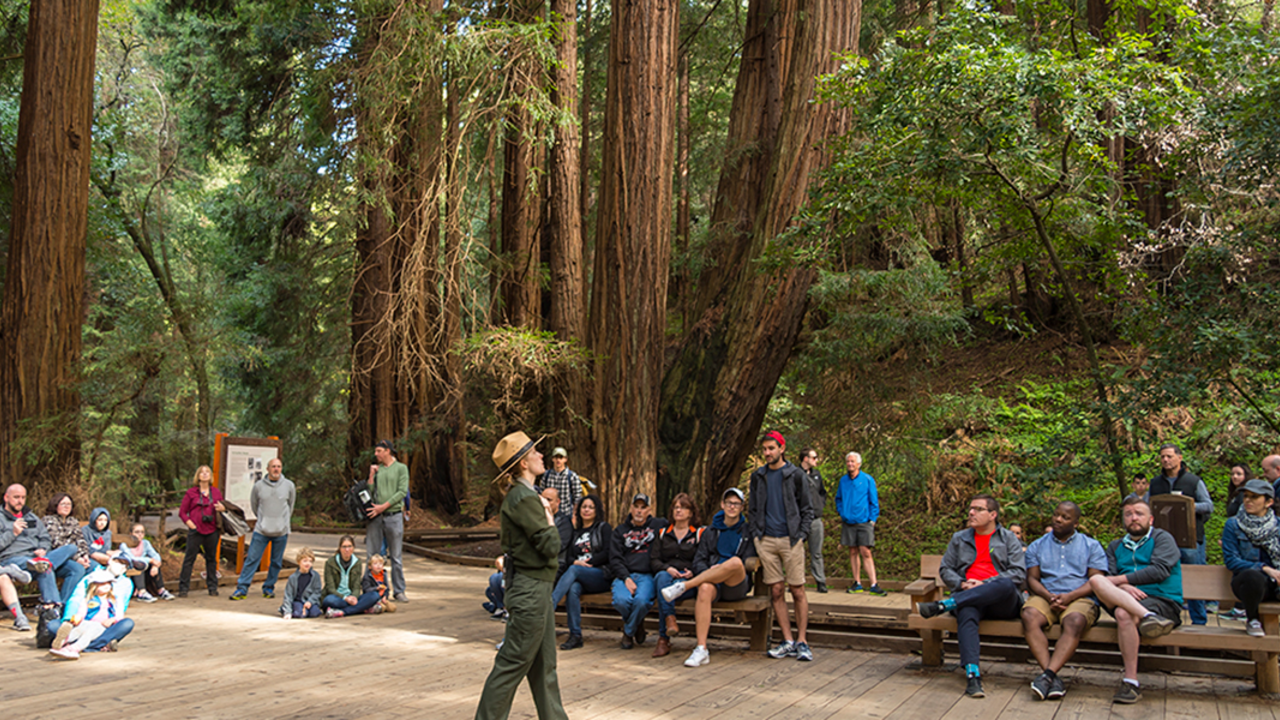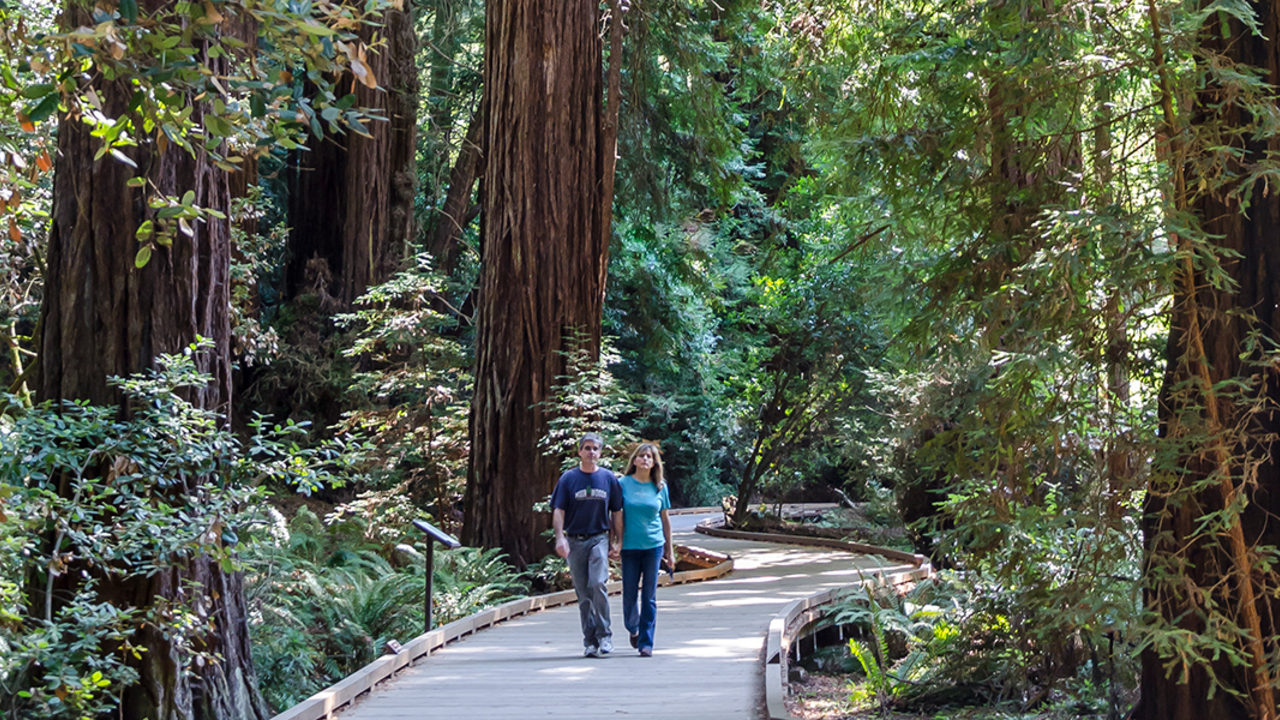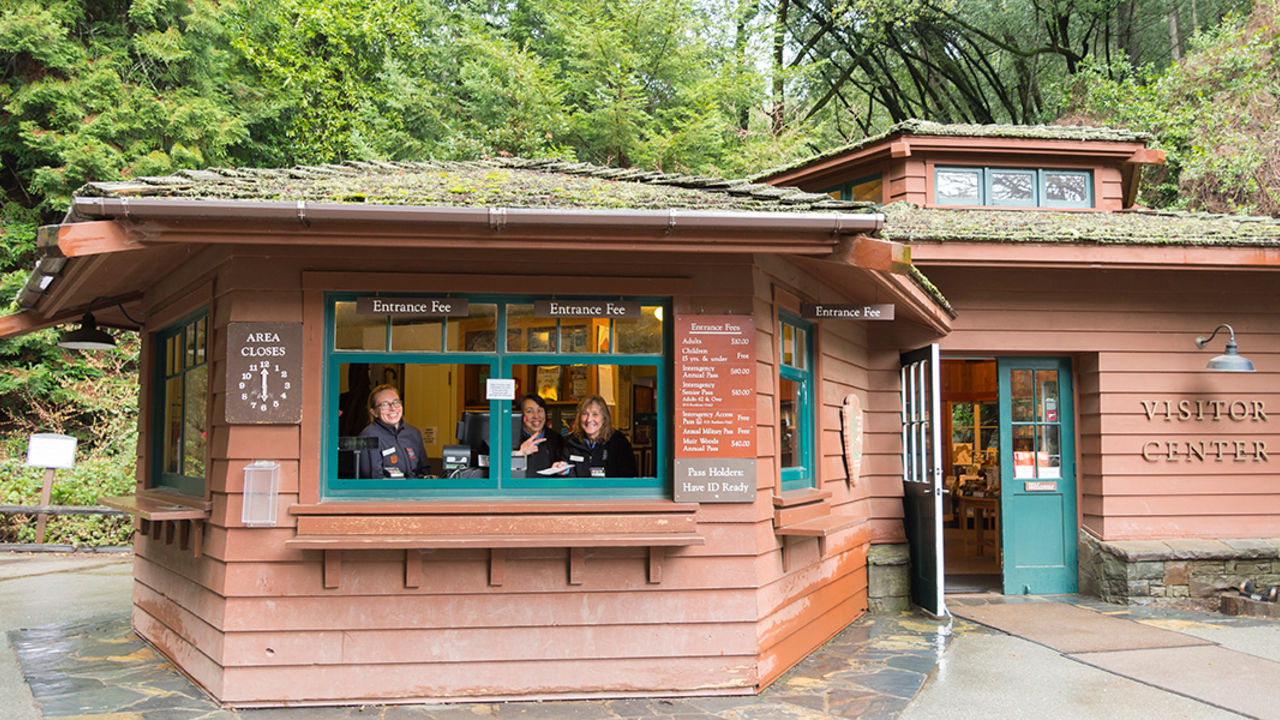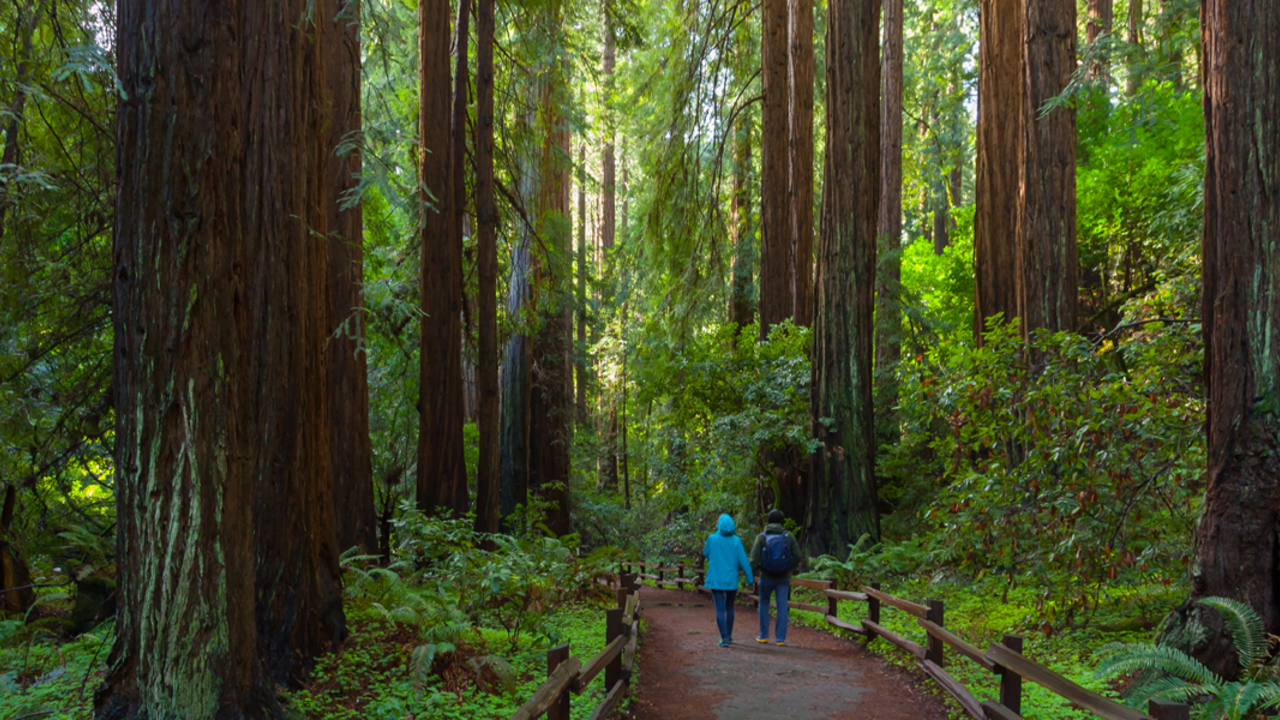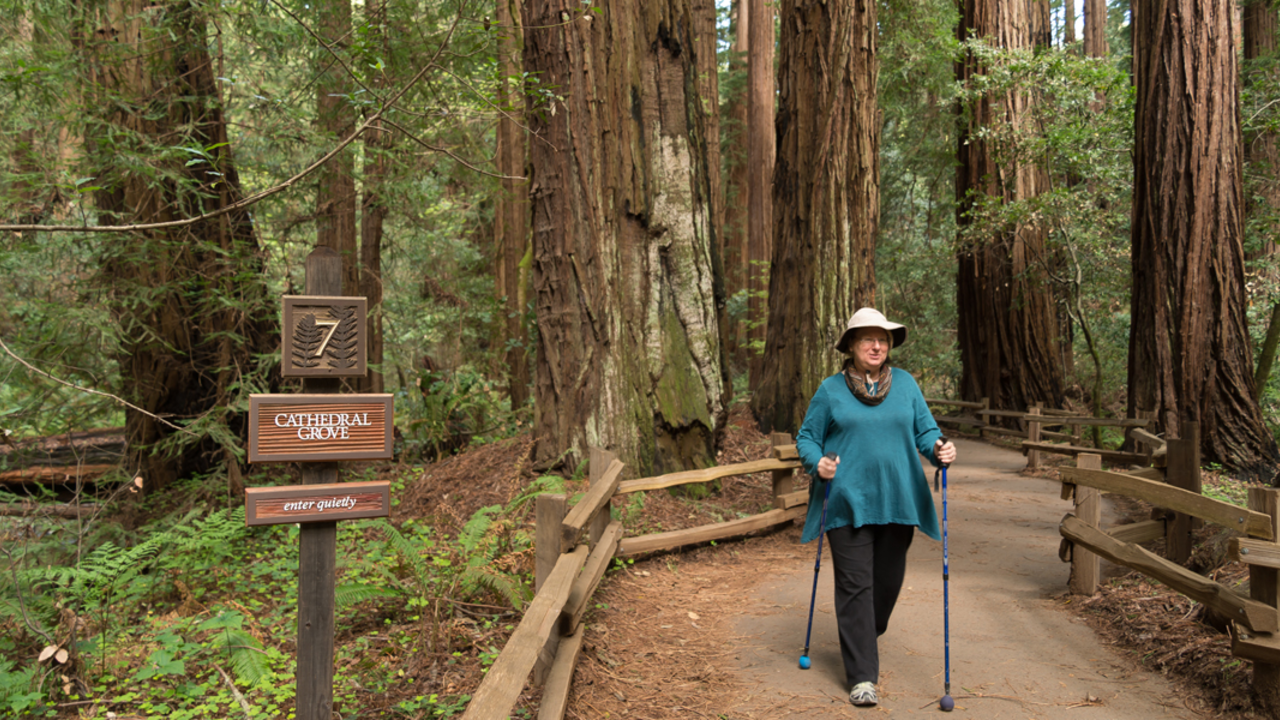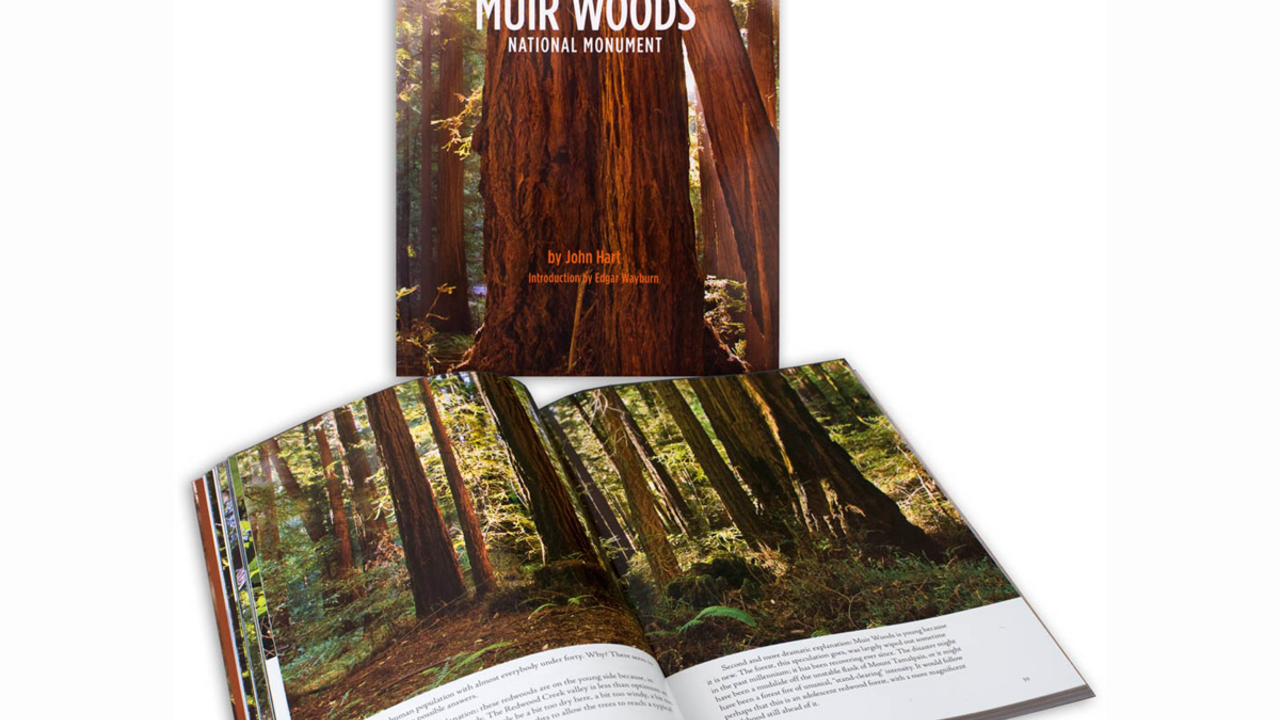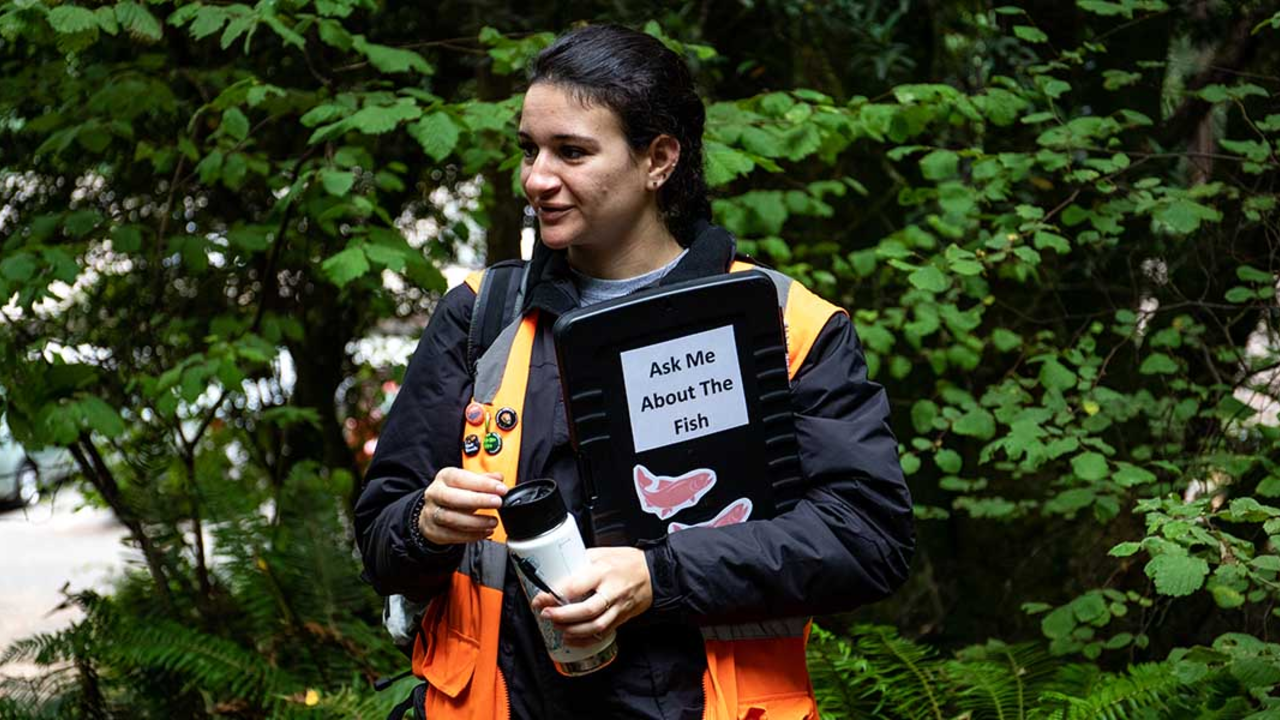Take a 'virtual' sunrise tour of Muir Woods
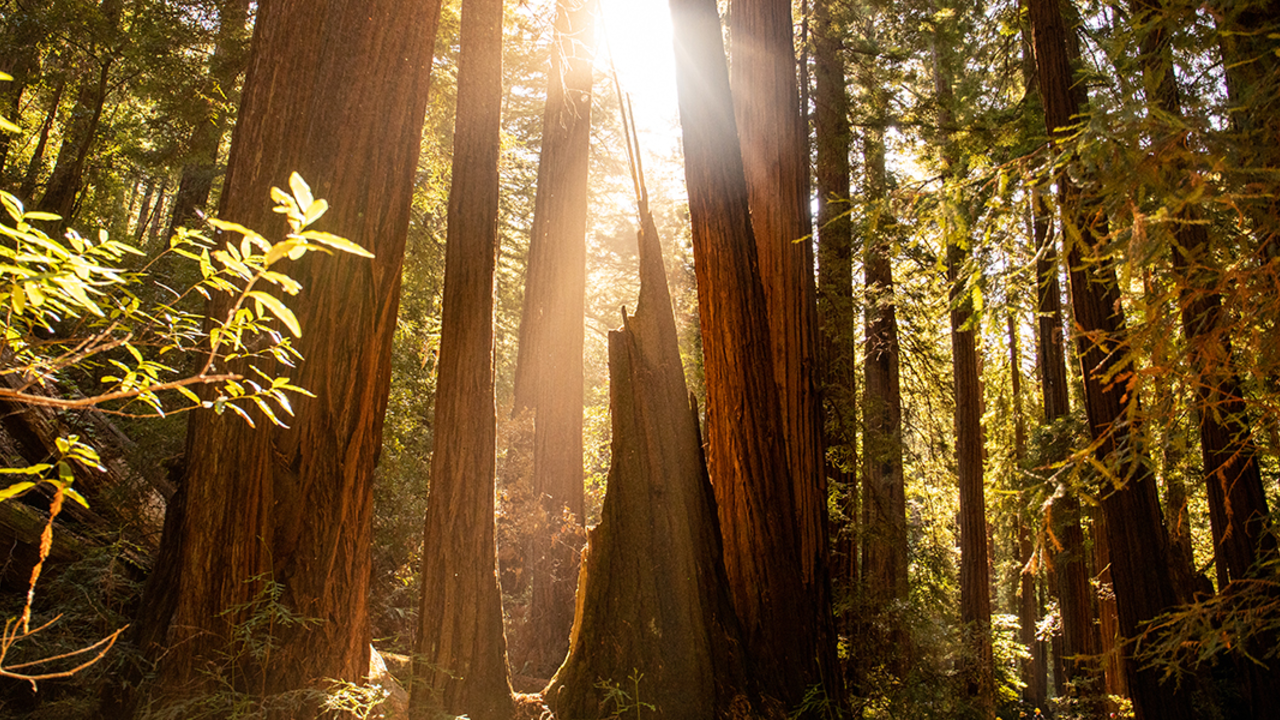
Paul Myers/Parks Conservancy
The Sunrise Tour of Muir Woods is one of the most special experiences in the national park system. The serenity of Muir Woods at dawn is a truly unique experience. Plus, you get to meet Nelson Stubbins, who has been leading the tours and imparting his knowledge and philosophy for years.
Muir Woods was closed until late June 2020, and guided walks like the Sunrise Tour were still canceled, so we asked Nelson to lead us on a “virtual” Sunrise Tour. Make sure to click on the header of each item to take that "stop," and please note that not every stop along the tour is immortalized here. To get the full experience, you'll have to sign up for a real Sunrise Tour with Nelson! As of November 2020, tours were still shut down out of safety amid the coronavirus pandemic. But keep checking back to our events page to see when tours may start back up again.
Here’s what the tour feels like, in Nelson’s own words:
4:30 AM ON A SUMMER SUNDAY
The shrill sound of an alarm at 4:30 a.m. is not very pleasant. But it’s the price of joining a Sunrise Tour around the summer solstice. In winter, Sunrise Tours begin at a more decent hour. The sun, known for her constancy, getting up each morning and going to bed each evening, can’t seem to quite make her mind up about what time of day to wake up or go to bed. Winter mornings can be pretty cold, which is no doubt the reason for the sun getting up later.
Crawling out of bed in the middle of the night to go traipsing through a redwood forest is not for everyone. Victims of a screeching alarm clock are likely to have second thoughts. Tuesday afternoon when you made your reservations it all sounded a lot more interesting than it does at 4:30 in the morning. But if you are the stout type with a middling sense of adventure, you roll out of bed nonetheless.
If you don’t know the road to Muir Woods, the adventure begins long before you arrive. The road curves so tightly through the hills even high beams fail to see around the corners. Early morning fog rolls off the Pacific Ocean, diffusing the light in a dreamy haze. Hopefully, you’ll be rewarded by spotting a black-tailed deer along the side of the road. If luck is with you, you might glimpse a gray fox dashing across the road. While a deer might take a good, long look at you before deciding whether you might be thinking about venison for breakfast, a fox will vanish like a phantom. For the short-legged fox, haste is the path to a long life.
5:30 AM
As the sunlight is just starting to peek over the coastal ridge to the east, we gather at the end of the parking lot. An unseen wild turkey gobbles, welcoming the first light.
After a short introduction, we head towards the Visitor Center, where the main trail begins...
Muir Woods Sunrise Tour
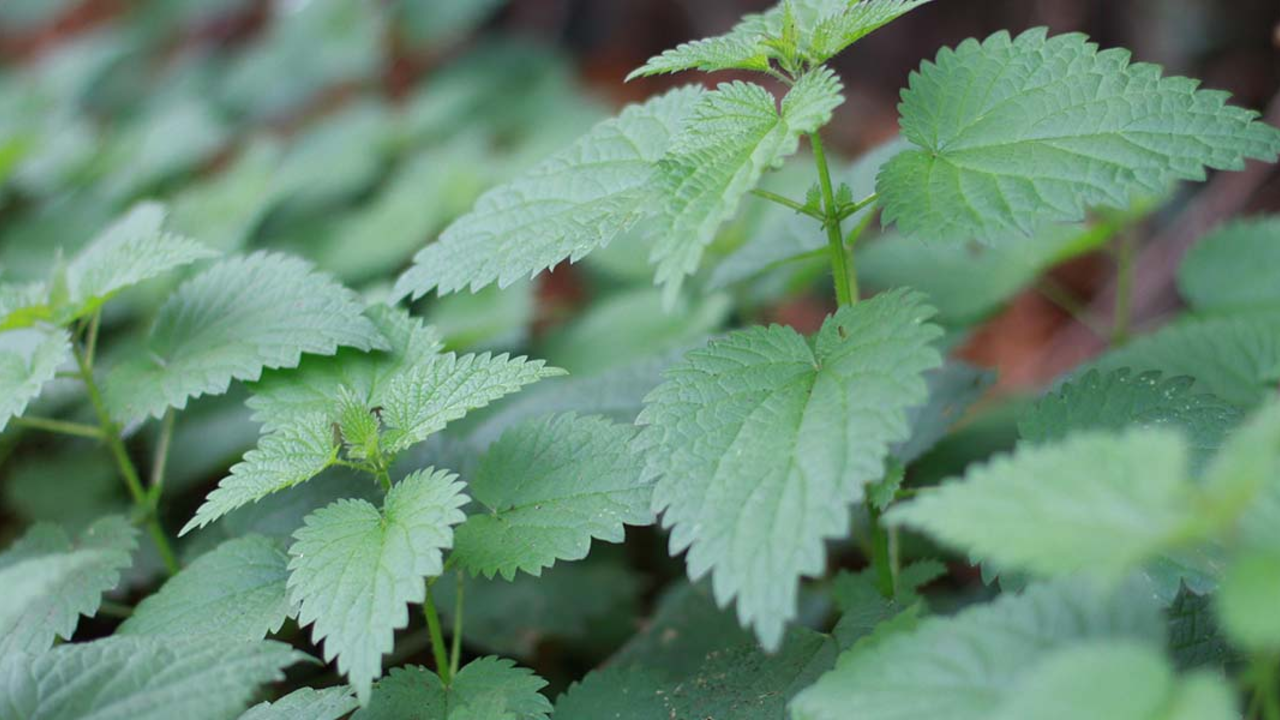
Stinging Nettle and Poison Oak
Here, behind the Visitors Center, are my two least favorite park residents.
First is a stinging nettle (Urtica dioica). If you brush against it, the hairs (trichomes) on the stems and leaves will inject you with a number of toxins. It can be pretty uncomfortable for a few days, having done it. Hydrocortisone is effective. If you're off in the woods and don't have access to the local drug store, urine is said to be effective. Or, so I have been told.
You can get your revenge on stinging nettle. Cooking it is said to remove the toxins. It is eaten around the world as a vegetable or soup. Similar to how linen is made from flax, stinging nettle can be made into a cloth.
If you go for the bizarre, there is an annual raw stinging nettle eating competition held in Britain. I had a hard time wrapping my head around the idea of anyone eating raw stinging nettle. At least, until I found out that the competition is part of a beer festival.
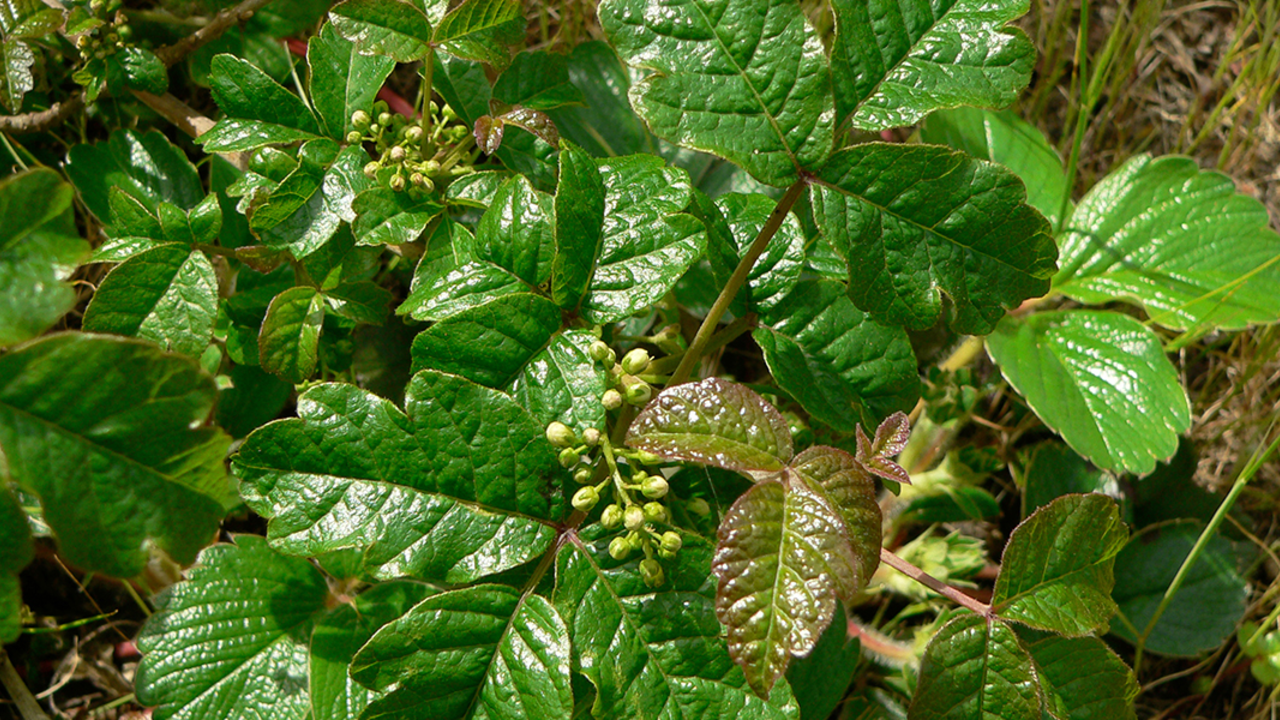
Next, there is poison oak (Toxicodendron diversilobum). About 80% of people are allergic to it. The best thing to do if you get into some poison oak is to wash the affected area. Unfortunately, you need to wash with soap and water as the allergen is an oil.
Both these plants require a fair amount of sunlight. So, you are not likely to find them in a redwood forest with its high canopy and limited sunlight reaching the forest floor.
Now that we've started the tour, I'll let you in on some of the disadvantages. This will not be a traditional visit to Muir Woods. For example, a normal visit to Muir Woods on a summer weekend would involve spending several hours looking for a parking space (at least, before the parking reservation system was implemented). As the Visitors Center is closed, there is no entrance fee to pay (the tour is free, although there is still the $8.50 parking reservation fee).
Lastly, you’re not going to see the park alongside the throngs of visitors that normally visit on a summer Sunday. Towards the end of the tour, you'll get a better sense of what the park typically looks like.
Coho salmon, banana slugs, and the yellow-spotted millipede
We're now directly over Redwood Creek. It is one of 10% of California rivers with a Coho salmon run. During the summer, when the water flow decreases, a sand bar builds up at Muir Beach where the creek flows into the Pacific Ocean. After the winter rains begin, typically late November or December, the creek bursts through the sand bar and salmon swim up the creek to spawn. After spawning, the salmon die. When the baby salmon hatch, they spend a year or two in the creek before heading off to the ocean where they spend their adult lives. In late December or early January, they return to their river of origin to spawn. The park is currently in the midst of a multi-year project to restore the salmon to the prior levels called Redwood Renewal.
The wildlife most often seen here in the park are black-tailed deer, banana slugs, and yellow-spotted millipedes.
Black-tailed deer are considered to be subspecies of the mule deer (named because their ears resemble those of a mule). The bucks grow their antlers between April and August. They rut (mate) in November or early December and the bucks lose their antlers between January and March. Fawns are born in late May or June. If you don't like black-tailed deer, here's something to consider: they eat poison oak. I don't know about you folks, but that makes them a friend of mine!
The yellow-spotted millipede is black with yellow spots. "Millipede" comes from the Latin for “1,000 legs.” Which is an exaggeration. They do not have 1,000 legs. The males have 60 legs and the females have 62 legs. So, if you want to know its sex...all you have to do is count the legs!
A hint about wildlife: Most animals are camouflaged to make it difficult for predators to spot them. If you see an animal that is brightly colored or has high contrasting colors (like yellow spots on a black background), it is likely toxic. Making yourself noticeable is a way or warning off potential predators not to mess with you. If the yellow-spotted millipede is threatened, it will secrete hydrogen cyanide. If the name of this gas seems familiar, it may be because it used to be used in the gas chamber at San Quentin State Prison about ten miles east of here. I've never heard of a human being harmed by one of these millipedes, as they secrete a very small amount. On the other hand, I would not walk into a closet with thousands of them.
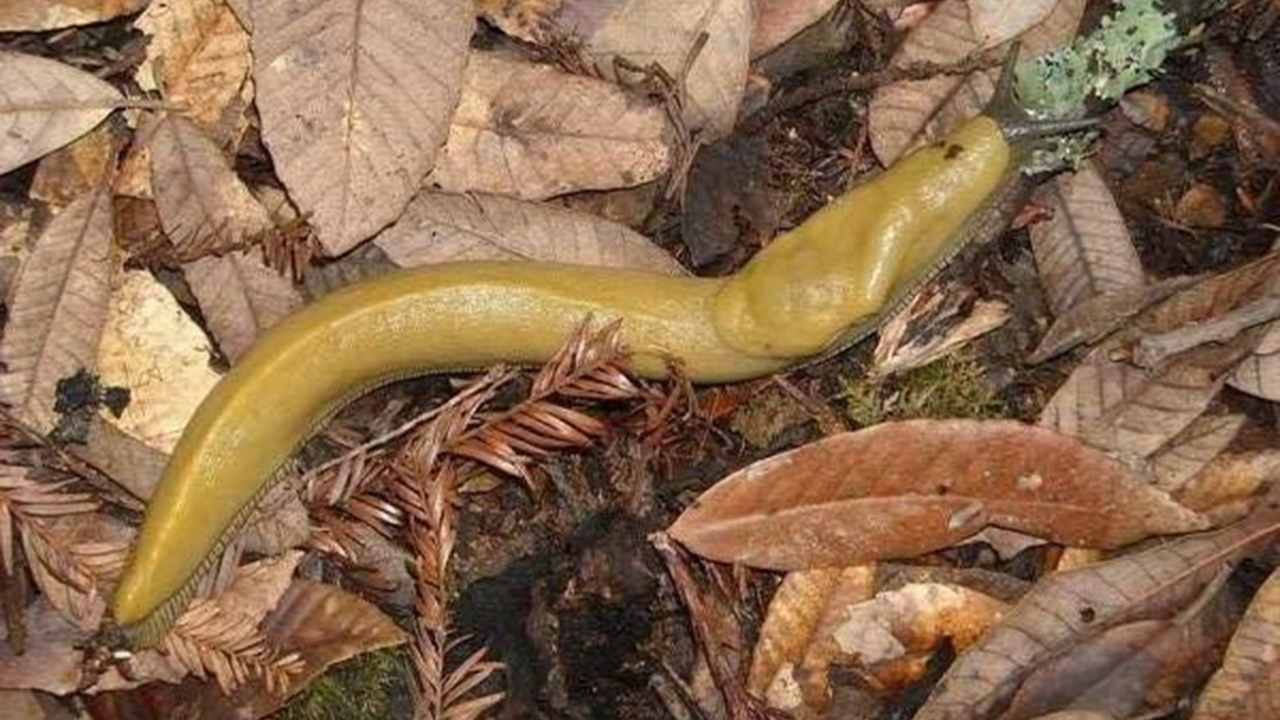
The banana slug is another common animal found here. In many places, like the Santa Cruz Mountains, they are bright yellow like a banana. Here in the park, they are yellowish brown or yellowish with mottled brown spots.
They produce a mucus that helps prevent dehydration and contains toxins. Banana slugs are less commonly seen in the summer when they may aestivate (the summer equivalent of hibernate) to get through dry summers.
I'd guess that the banana slugs here are less toxic then the ones in the Santa Cruz Mountains. At least, that could be one explanation of why they are not as bright yellow, that is, it is less advantageous for them to be highly visible.
Alternatively, I've heard that some animals have learned to scrape them on the ground, removing the toxic mucus, and then have them for lunch. This might be another reason why they evolved to be less bright yellow.
Just north of here in Sonoma County, there used to be an annual Banana Slug Festival that held banana slug races. Okay, it's not quite Formula One auto racing. Though, when a banana slug is in a hurry it can get up to the astounding speed of 6.5 inches a minute. The festival also held a banana slug cooking competition. The winning entry was the one that could best disguise the taste. Apparently they taste pretty horrible.
The Founding of Muir Woods
We've arrived at the Pinchot Tree, one of three named trees in the park. It is named in honor of Gifford Pinchot who was the first head of the U.S. Forest Service and instrumental in the creation of Muir Woods National Monument.
Why is this a national monument and not a national park? And why the park is named after John Muir?
National parks are created by acts of Congress. We have Yosemite National Park because Congress said so. However, in 1906 Congress passed the Antiquities Act which allows the president to declare land to be a national monument by executive order. The immediate cause of the Antiquities Act was to protect ancient Native American sites which were being looted by treasure hunters. President Theodore Roosevelt realized that the broad wording of the act permitted it to be used for a wider purpose. Since it often takes Congress years to pass legislation to create a national park, the Antiquities Act allowed for a speedy protection of endangered areas. For example, the protection of the Grand Canyon was being debated in Congress since 1882 without results. Roosevelt stepped in and declared it a national monument in January 1908. Congress eventually got on board in 1919 and made it a national park.
Redwood Canyon, as this area was known before it became a national monument, was owned by a local, wealthy conservationist, William Kent. In 1907, he was served with eminent domain papers from the North Coast Water Company. (When the state wants to build a freeway through your house, they may acquire the property by eminent domain. A court determines if the public good overrides the property rights of the land owner and may force the sale of the land.) Kent, learning of the Antiquities Act, contacted his old college friend, Gifford Pinchot, to explore gifting the land to the federal government. Pinchot took up the matter with Roosevelt. On January 9, 1908 (two days before the creation of Grand Canyon National Monument), Roosevelt signed the declaration to make Muir Woods a national monument.
So, why is it named after John Muir when Muir had nothing to do with its creation? Roosevelt had suggested calling the park Kent Woods National Monument. Kent objected and requested that the park be named after the great conservationist, John Muir.
Read more about Muir, Kent, and their racist histories in this article.
In 1904, Theodore Roosevelt pledged that he would not run again in 1908. Although regretting the promise, he kept his word. Towards the end of presidency, he used his power as head of the Republican party to select his heir apparent, Howard Taft.
After Taft was elected, Roosevelt—and most of the conservation community—regretted the choice. Rather than keeping Secretary of Interior James R. Garfield as Roosevelt thought had been previously agreed to, Taft replaced him with Richard Ballinger. Ballinger's policies were often detested by conservationists and his reign saw a number of scandals (which were investigated although nothing illegal was ever proven). Pinchot, who was convinced of Ballinger's malfeasance, went public with his criticisms. Taft responded by firing Pinchot on January 7, 1910.
The Sierra Club, founded by John Muir, supported Pinchot, an honorary vice president of the club. On May 5, 1910, the Sierra Club dedicated the Pinchot plaque at Muir Woods in a ceremony attended by William Kent. It is hard to imagine that these events are unrelated and that the plaque was not intended as a political statement.
After the 1906 earthquake, San Francisco was looking for new supplies of water. The city focused on building a dam in Yosemite National Park's Hetch Hetchy Valley which set off a controversy in the conservation community. In the early days it was friendly argument, but by 1911 or 1912 it had become a heated debate, splitting the movement into the preservationists like John Muir who opposed the dam and the more utilitarian approach of people like Gifford Pinchot who were open to the idea. By 1913, when the dam was approved, Pinchot was no longer an honorary vice-president of the Sierra Club.
I surmise that the plaque's appears here today because its placement was in the short interval between Pinchot's firing in January 1910 and the split in the conservation movement around 1911.
The plaque is also noteworthy as it was cited as exemplary by Charles Punchard Jr., the first landscape architect for the National Park Service. Punchard surveyed the parks from 1918 to 1920. He was an advocate and pioneer of an architecture style known as "National Park Service rustic" which emphasized structures that blended into the natural environment. Punchard noted the Pinchot Plaque at Muir Woods, a bronze plaque attached to a large rock, as a model for others to follow.
Coastal Redwoods
We're under a coastal redwood. There are a couple of things that make them noteworthy.
First of all, they grow in one and only one place in the world: along the western coast of the U.S., from just north of the Oregon border to Big Sur, south of San Francisco. And only along the coast.
The coastal redwood is the tallest living thing on earth. The tallest redwood is about 380 feet tall (115 meters). It can be difficult to get a good sense of just how high these trees grow as it is hard to see the tops of the larger trees. Maybe this helps: You've all seen pictures of the Statue of Liberty. Maybe some of you have visited her. If she visited the tallest redwood, she would not be able to reach the top. And that is true even if she climbed on her pedestal and got on her tiptoes. The taller trees here in the park would not fit under the Golden Gate Bridge.
They are also rare. About 95% of the old-growth redwood forests have been logged. We are standing in part of that 5% that have escaped the logger's axe.
Coastal redwoods are also old. Here in the park, there are redwoods thought to be around 800 years old. Further north, they have been around for over 2,000 years.
They are not, however, the oldest trees. Some of their brothers, the giant sequoia, are 3,200 years old.
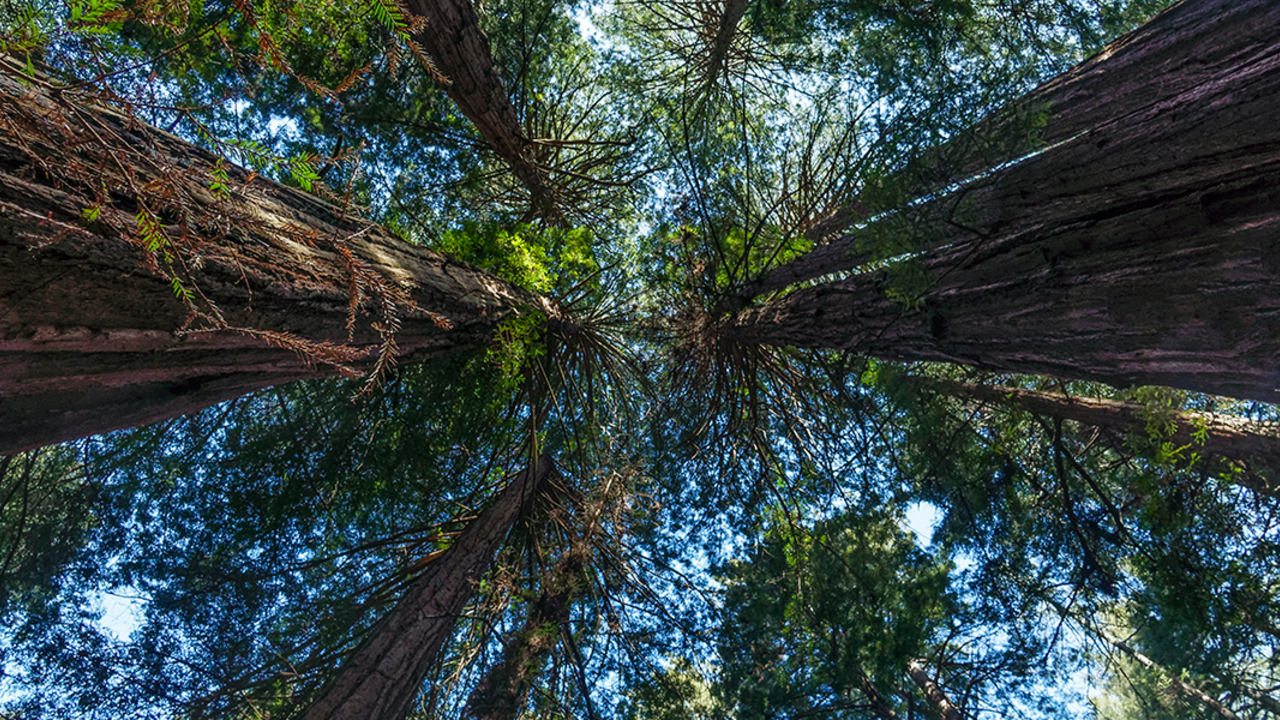
Curious about the difference between the coastal redwood and the giant sequoias? The giant sequoia live in only one place on earth: the western slope of the Sierra Nevada mountains. They are a little shorter than the coastal redwoods, but thicker. So if you are wondering which tree is largest, at least in the sense of mass, that would be the giant sequoia. The coastal redwoods are relatively tall and thin.
It is easy to tell them apart if you know one thing: where you are. If you are along the coast, you are looking at a coastal redwood. If you are in the Sierra Nevada mountains, you are looking at a giant sequoia. They do not share habitat.
There is one other redwood that exists today: the dawn redwood. It grows naturally in only one place in the world: a small region of China. It's a normal size tree, not a giant.
To complete the story about old age, the giant sequoia are not the oldest tree. The oldest is the bristlecone pine that grow at high elevations scattered through western United States (in particular the White Mountains of California and Nevada). They can get to be over 5,000 years old. They are a small, withered looking tree. Not majestic like these guys, something that you might walk by without noticing.
Redwoods are not only old in the sense of living long, but they have been around for a long time. While it is not known the exact age of the species, we do have fossil evidence of a redwood-like tree that dates back to the Jurassic era (about 200 million years ago). At one time, when the earth was wetter and warmer, redwoods had a much larger range. We have fossil evidence of redwoods from Asia and Europe and a few from the Southern Hemisphere.
Redwood water requirements and redwood bark
Redwoods are a bit odd. For example, they have a drinking problem. A mature redwood can consume 300-500 gallons (1100-1900 liters) of water a day. Where do they get all that water?
In the winter, it rains. During the winter months, the National Park Service frequently holds demonstrations of water falling out of the sky. (Yes, that is a joke.) However, Northern California is typically dry during the summer months. Unlike the East Coast, almost all of our precipitation occurs during the winter. What we do get here during the summer months is fog.
Taking a swim along the Northern California coast is not for the faint of heart. The water along the coast is really cold. During the summer, the Central Valley to our east gets quite warm. The two together produce coastal fog that blows off the ocean inland. The fog condenses on the redwood needles and drips to the forest floor.
Redwoods have also developed a clever adaptation in response to living in the fog belt. The upper needles are capable of absorbing water.
Since water is required for photosynthesis and pulling water hundreds of feet to the tree top is a challenge, this adaptation is probably one of the reasons that redwoods are the tallest living things on earth.
Another odd thing about the redwoods is their bark. A mature redwood can have bark up to a couple feet thick (around 60 cm). The bark has high concentrations of tannin, which gives the tree its reddish color. Wine drinkers may be familiar with the distinctive tasting tannin found in red wine. Tannin is also found in black tea. It’s an insecticide, a pesticide, and a fire retardant.
You may notice that you'll see fewer birds in a redwood forest than you might find elsewhere. Why? Because of the tannin. Since insects don't feed on the redwoods (tannin is an insecticide), there are less insects. Less insects means less foods for birds, hence less birds.
If you look around you'll see many trees covered with moss, but not redwoods. Why? Because of the tannin.
Fetid Adder's Tongue
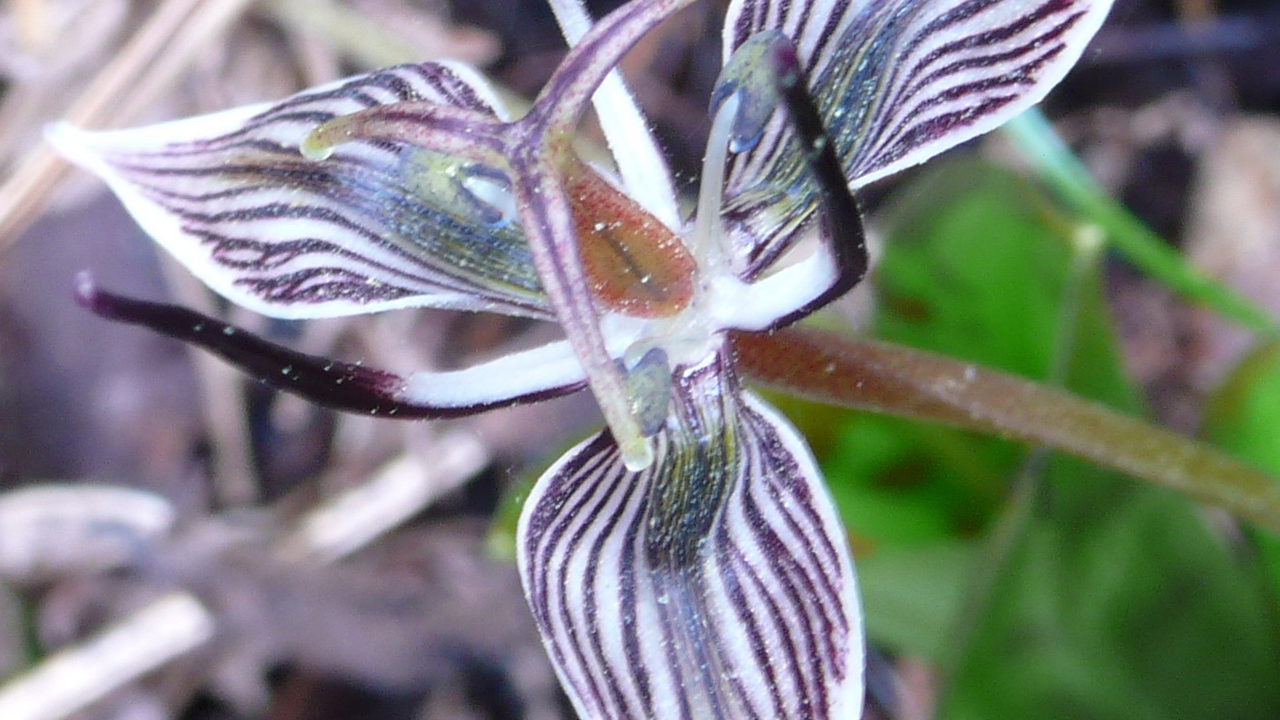
Here is our most social plant in the park: the fetid adder's tongue. Like all flowering plants, it relies on pollinators to reproduce, primarily a species of gnat.
It feeds the gnats and the gnats provide transportation services for its pollen. But it also has a relationship with ants. The plant's seeds have a little chunk of food that are a favorite of ants. The ants pick up the seeds, take them back to their ant holes, and discard the seeds after they have had their feast. So, the plant feeds the ants and the ants provide transportation services for their seeds.
It is also a hasty plant: it blooms in February, the first plant to flower in the park.
The plant is not loved by all. When it flowers it is said to give off the scent of rotting meat. Maybe you have to be a gnat to truly appreciate the fetid adder's tongue.
Redwood roots
Another odd thing about redwoods are their roots. Imagine a mature redwood on a windy day. Imagine the forces it must cope with to stay standing. It might make you think that the roots dig as deep into the ground as the trunk soars above ground. But they don't. Redwoods have shallow roots. Their roots are no more than 10 feet (3 meters) deep. They make up for the shallow depth by extending to a radius of up to 100 feet (30 meters).
You may have wondered about the boardwalk that we were on at the beginning of the Redwood Creek Trail. It is there to prevent compaction of the soil and stressing the shallow roots of the redwoods.
United Nations
This is Cathedral Grove where some of the oldest and tallest redwoods in the park grow.
Towards the end of WWII, a conference was held in San Francisco to create the United Nations. During the planning phase, the director of the Save the Redwoods League wrote a letter to Secretary of the Interior Harold Ickes suggesting that a session be held at Muir Woods. What better place to discuss world peace that among these ancient, majestic trees? Ickes liked the idea, passed it along to President Roosevelt (FDR), who also liked the idea, and so a session was planned in the park.
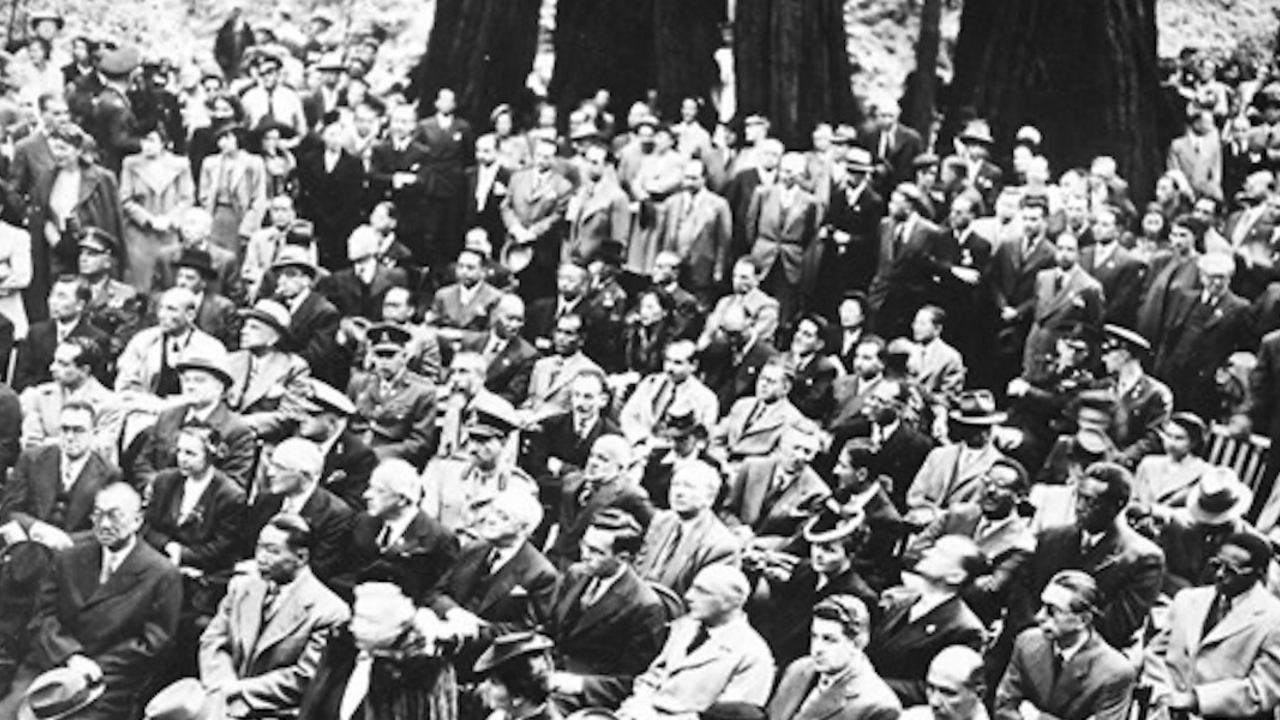
After Roosevelt died on April 12, 1945, the Brazilian delegate to the conference suggested that the session to be held at Muir Woods be a memorial to FDR. On May 19,1945, a little over 75 years ago, the memorial was held right here. On the right (east side of the trail) is a plaque commemorating the event and on the left is a photograph of the memorial.
Read more about the historic UN event at Muir Woods.
Redwood reproduction
Redwoods are a conifer, a cone-bearing tree. You’ve all seen pine cones, typically around 5 inches (13 cm) long. Sugar pine cones get really large; they grow to 20 inches (51 cm) long or even longer.
Most people expect redwoods to have massive cones. Big tree, big cones. But they don't. A redwood cone is about the size and shape of an olive. They have 20-30 seeds. The seeds look like the chili peppers people put on pizza.
When the seeds mature, they fall to the forest floor and look for a nice, tasty morsel of ground to grow a redwood. However, if you look around you don't see much ground. The forest floor is mostly covered with duff (nettles) and plants. The chances of a redwood seed actually growing into a redwood is very slim. Not only do they have to fall onto open ground with the right moisture and nutrients, but the seeds also have a high infertility rate.
One of the things that make redwoods unusual, at least for a conifer, is that they have another way to reproduce. The thing that looks like a tumor at the base of the tree is a burl. It's a collection of redwood buds. When the tree is stressed, these buds can produce sprouts. It’s thought that most of the redwoods here at Muir Woods were created from sprouts.
Family circles are commonly seen (sometimes called fairy circles). So let me tell you the story behind them. All good stories begin the same way...
Once upon a time, there was a redwood. It became stressed and began to sprout around the base. After a few decades—or centuries—the tree fell down. What remains is a circle of redwoods that all sprouted from the same parent, hence a family circle.
Civilian Conservation Corps and the salmon restoration project
We’ve arrived at Fern Creek. The stone bridge was built by the Civilian Conservation Corps (CCC) during the 1930s.
During the Great Depression, President Franklin Roosevelt created the CCC to employ people, get money back into the economy, and improve the country's infrastructure. They also worked in the country's national parks and monuments.
Besides building this bridge, the CCC worked on trail improvements and built revetments along Redwood Creek.
It was the thought that one of the problems in the park was that the heavy winter rains would flood the creek and erode the banks. To solve this "problem," the CCC built revetments (also called “rip-rap”) along the banks to channel the water and get it out to sea.
Later, we learned this was not such a great idea. Not only do the heavy rains bring sediment that enriches the forest, but channeling the water is detrimental to coho salmon. A natural stream, with places for the salmon fry (young salmon) to hide, increases their survival rate.
When I first learned of the revetments, I thought how stupid people can be. Not you and me, of course. I mean other people! But during the 1930s the Great Plains experienced horrendous drought and winds swept away the topsoil. Erosion was very much on people's minds. It is not hard to imagine why it seemed a reasonable thing to do. Our only choice is to do the best we can given our current knowledge, even if our knowledge turns out to be incomplete or even wrong.
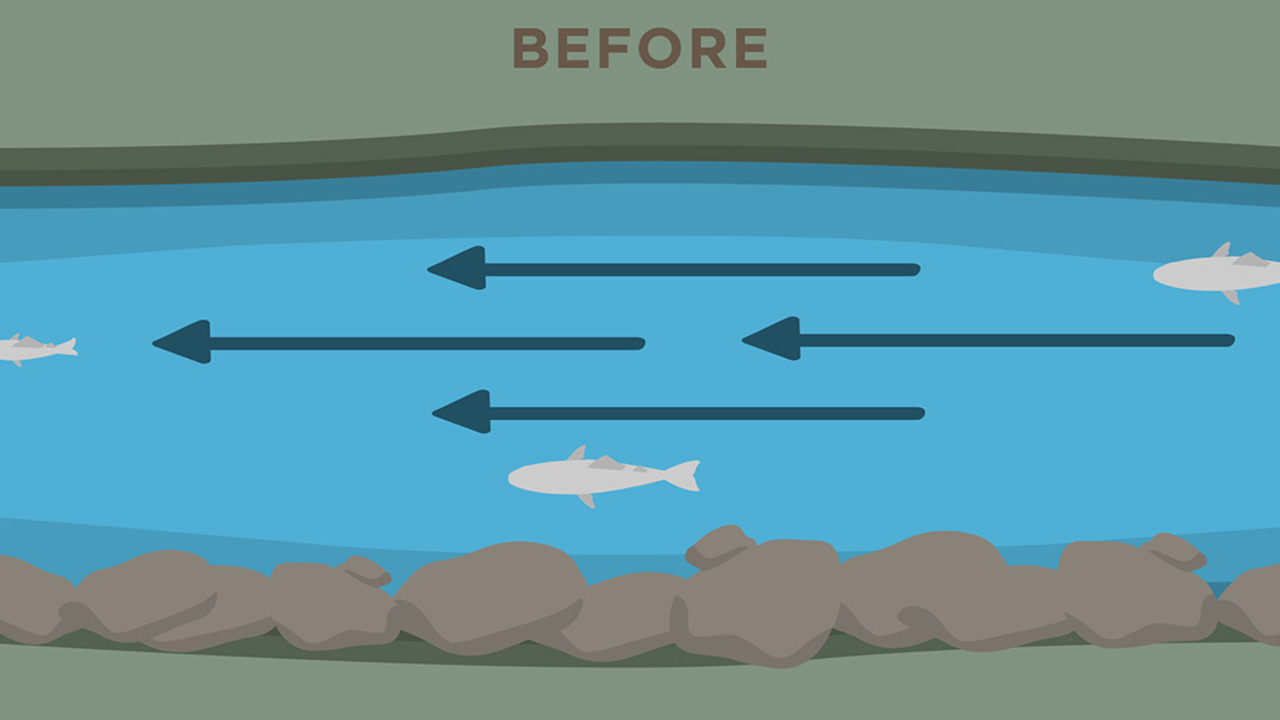
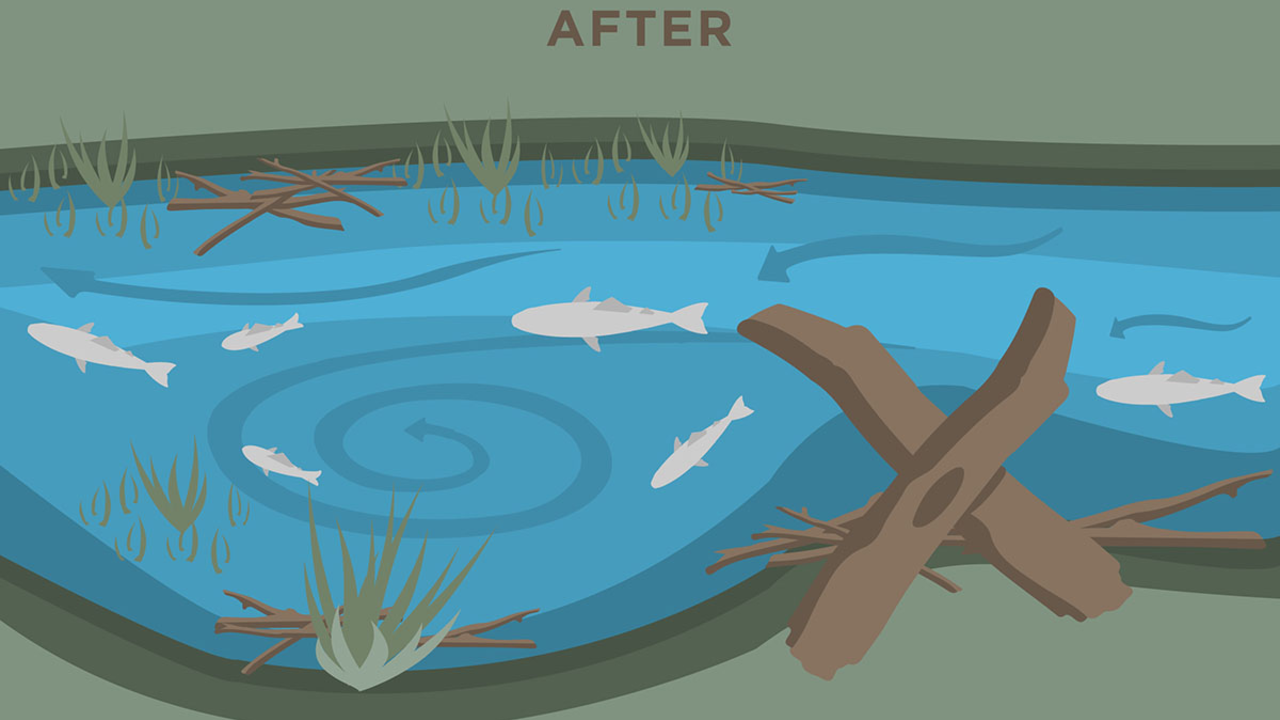
The park is in the midst of a multi-year project to remove the revetments, restore the creek, and the original salmon population. This will increase the creek's water level, so the four bridges across Redwood Creek need to be raised. And then, in order to maintain ADA (Americans for Disabilities Act of 1990) accessibility, the approaches to the bridges need to be modified to keep the ramp angles minimal.
You may have noticed the work in progress to reroute the approaches to some of the bridges. Read more about the Redwood Renewal project.
In addition to the work here in the park, the CCC refurbished the Mountain Theatre and rebuilt the fire lookout atop Mt. Tamalpais. What is today the Alice Eastwood Campground was the location of the original CCC camp.
Alice Eastwood
This is the Alice Eastwood Trail, where we will begin to climb the ridge to Camp Alice Eastwood.
Eastwood was a botanist who worked as the curator for California Academy of Sciences for over 50 years. She published over 300 scientific articles, including one that described the differences between the upper and lower needles on coastal redwood (later it was discovered that these upper needles are the ones capable of absorbing water). There are 17 species named for her and two genera.
Eastwood collected botanical species all over the west from the Yukon to Mexico, often alone, sometimes on foot and sometimes on horseback.
Alice was born in Toronto, Canada in 1859. When she was six years old, her mother died and her father left her with an uncle. In 1873, her father, who was living in Denver, sent for her.
Eastwood spent a good part of her adolescence in and out of school, taking care of her family (she was the oldest of three children) and working to supplement her father's income. She nonetheless managed to graduate from high school as valedictorian. Alice accepted an offer to teach high school, although her true interest was in botany. At the end of an 1891 botanical collecting trip, she visited the California Academy of Sciences. The next summer, she was offered the position at the Academy.
Everyone seemed to like her; she made friends wherever she went. Few people are equally at ease at a women's botanical club as at an International Botanical Congress.
Albino Redwood
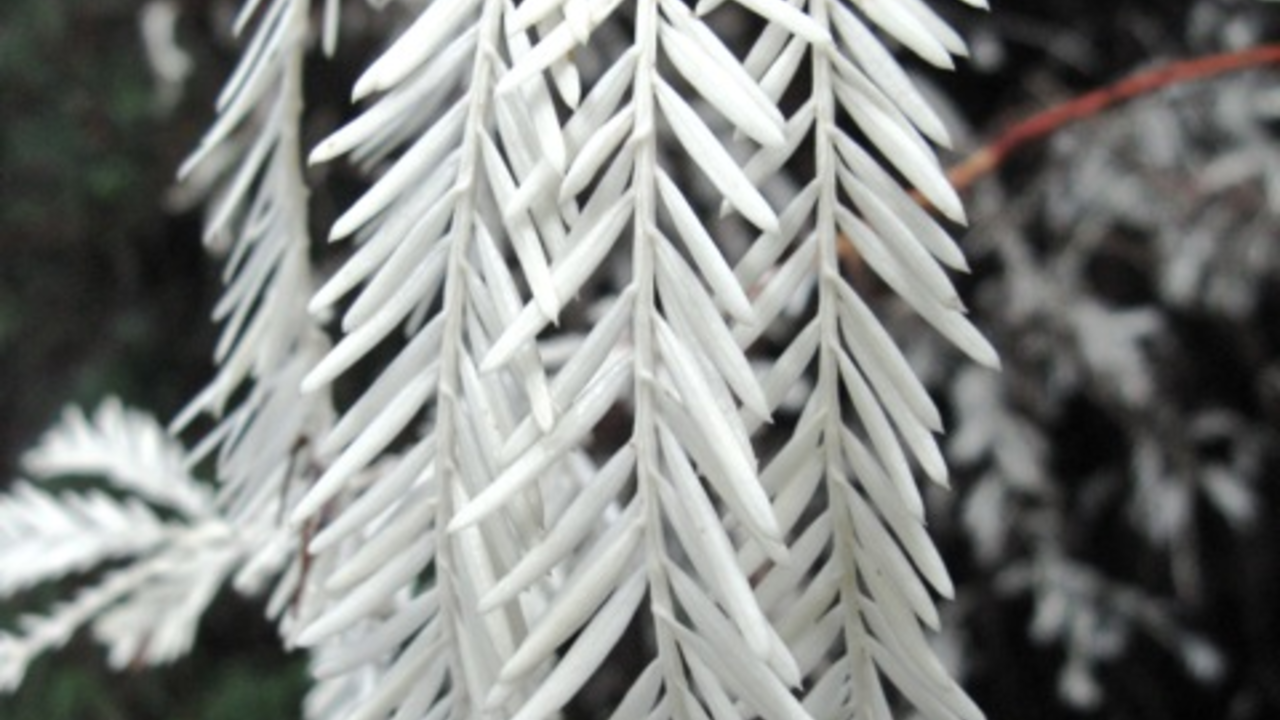
It may not look like a redwood, but it is. The needles are light green, almost white. This is an albino redwood. It's a different color because it lacks chlorophyll, the substance in plants that converts sunlight into sugars or food for plants.
Traditionally, albino redwoods have been considered parasites. Not being able to feed themselves, they live off another redwood to which they are attached. A PhD student at UC Davis noticed that albinos have high concentrations of heavy metals. He contends that they are not parasitic, but symbiotic. The albino absorbs the heavy metals and receives nutrients; the main tree feeds the albino while benefiting by the reduction of toxic metals. Once he completes his experiments, we will learn whether his contention is correct.
Mt. Tamalpais and Muir Woods Railway, and the second Muir Inn
In the early years, this was the primary entrance to the park. Starting in the late 1800s, there were outfitters in Mill Valley that offered guided tours by foot or horseback to Redwood Canyon.
In 1896, a scenic railroad was built from Mill Valley to the top of Mount Tamalpais. Muir Woods is on the southern slope of Mt. Tam. The eight mile railroad had, if you counted up all the curves, the equivalent of 42 complete circles. It was marketed as the "Crookedest Railroad in the World." For visitors of San Francisco around 1900, it was The Thing to Do. You boarded a ferry in San Francisco to Sausalito, took the North Pacific Coast Railroad from Sausalito to Mill Valley, and then changed trains to the scenic railroad. Visitors then either hiked down the mountain or took the train back to Mill Valley. In 1902, they introduced gravity cars. These were open-air cars that went down the mountain without the benefit of a locomotive. The gravity cars were marketed as "the longest roller coaster in the world."
In 1908, when Muir Woods became a national monument, a spur was built to access the park. The original terminus of the spur was what is today Camp Alice Eastwood, the turnaround point of our tour. The railroad built a small hotel there called the Muir Inn. In 1913, the inn burnt down and, rather than rebuilding at its original location, they rebuilt it here, extending the railroad to the new location. If you look north (up the slope), you can just make out the flattened area where the railroad ran. The second Muir Inn was here from 1914 until the railroad shut down in 1929.
What caused the railroad to terminate operations? The railroad had seen declining revenue as the automobile became more popular. In 1929, a large fire on Mt. Tam destroyed some track. Capital was required to just keep the railroad running. After the 1929 stock market crash, investment capital dried up and they shut down the railroad.
Camp Alice Eastwood
This is the original terminus of the Mt. Tamalpais and Muir Woods Railway and the site of the first Muir Inn. The railroad ran along what is now the access road.
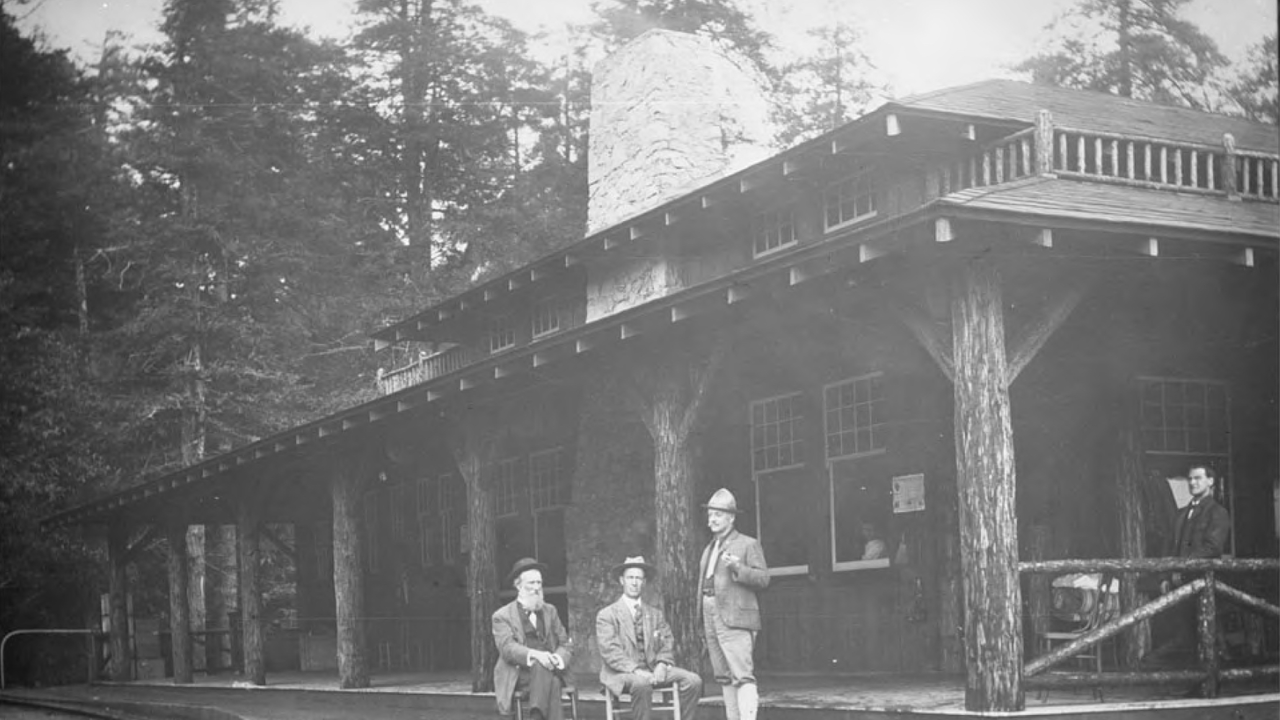
This is also the site of the Civilian Conservation Corps camp. When the state park was converting it to a public campground, a state park ranger suggested that, rather than naming a tree after Alice Eastwood as her friends were planning to do on her 90th birthday, they name the campground after her.
We begin our descent back to Muir Woods along the Fern Creek Trail. As we descend, you'll notice some cement blocks on your left. These are the foundations of cabins that the railroad rented to visitors.
Please be aware that National Park Service regulations strictly forbid tripping on any of the rocks or roots on the trail (yes, that is a joke). The trail is uneven. Watch your footing!
Making a living in a redwood forest: Redwood sorrel, wooden nickels, and the California Bay Laurel
If you look around, you'll notice that the redwoods almost always grow perfectly straight. In contrast, you'll often see the California Bay Laurel growing in every direction.
Like you or me, the residents of the park (the plants and animals) have to make a living. Redwoods make a living by growing to the top of the canopy to access light. No one is going to grow taller than a coastal redwood! So, growing straight is a pretty good strategy. The shorter California Bay Laurel rely on their ability to bend every which way to find a bit of light streaming through holes in the canopy.
If you smell a California bay laurel leaf (rubbing or scratching the leaf brings out the smell), it may remind you of eucalyptus. It has a camphor or menthol odor. But it's actually related to something you might have in your spice cabinet. The bay leaves you buy at the supermarket comes from a European variant of the tree, the bay laurel. You can cook with the California bay laurel, albeit it has a bit of stronger taste.
Another resident of the park is a dusky-footed woodrat. They’re nocturnal herbivores, although they may munch on a tasty insect to complement their diet of leaves, fruits, and nuts. After a night hunting for food, the dusky-footed woodrat may pick up a California bay laurel leaf and carry it back to its den to keep the fleas out.
But that's not what I really wanted to talk about. I wanted to talk about wooden nickels.
Do you know the expression "Don't take any wooden nickels”? The expression seems to be disappearing from the language. Older people seem to know it, while younger folk are less likely to have ever heard it. The expression dates back to the early 1900s when wooden tokens were often used for promotional purposes and purportedly passed off as real money. The expression came to mean "don't be duped" as there are no real wooden nickels. The expression was often used humorously in parting.
It’s said that the only wooden coins still accepted as legal currency are made from the California bay laurel.
In the midst of the Great Depression, the small town of North Bend, Ore. had its one bank close. These were the days before credit cards or debit cards. It was a cash economy. The mayor of the town decided to mint his own coins to keep the city's economy going. He made a series of coins of different denominations all made from the California bay laurel. No nickel. The story goes that he avoided making a nickel because ... well...he worried that people would make fun of them or refuse to accept them! Technically, he was violating federal law (only the federal government has the right to mint coins. As he was not trying to replace U.S. currency, but just trying to solve a local problem, no actions were taken.)
When the bank finally reopened, people were encouraged to exchange their wooden coins for U.S. currency. Most people did. Some kept them as souvenirs.
Eventually the city council is said to have voted that they would honor the wooden coins in perpetuity (forever). If you hear this story in Oregon, they may tell you that coins were made from an Oregon myrtle. Same tree, different name.
If you look around at the ground, you'll see something that many people think is clover. It is redwood sorrel, not at all related to clover. It's common to see as ground covering in a redwood forest. Redwood sorrel makes a living by being adept at photosynthesizing at low light levels. It can photosynthesize at 1/200th normal light levels. In the shade of the redwoods, it can thrive where most plants could not survive. Redwood sorrel is edible, although you should not eat too much of it as it contains oxalic acid which is associated with the formation of kidney stones. The acid was first isolated by chemists from wood sorrels (Oxalis genus) and thus gave the acid its name. (The scientific name for redwood sorrel is Oxalis oregana.) But then again, rhubarb, parsley, and spinach also contains oxalic acid. So much for Popeye (although cooking spinach does reduce the oxalate levels).
I would like to make sure that everyone feels secure and comfortable. So, I want to warn you that we may encounter some two-legged animals as we return towards the park entrance. Rest assured that are usually quite harmless!
William Kent and his complicated legacy
This is the Kent Tree, one of the three named trees in the park. When it was named, it was standing a bit straighter. The tree fell in 2004. What might surprise you is that it is not a redwood; it is a Douglas fir. This tree was chosen because it was said to be Kent's favorite tree. Notice that the tree fell over the trail and the trail has been rerouted around the tree.
We spoke earlier about Kent's role in the creation of Muir Woods and how he declined having the park named after him, preferring the honor go to John Muir.
Kent came from a wealthy Chicago family that made a fortune in the meatpacking business, selling cans of meat to the Union army during the Civil War. This was the time of the great Robber Barons, industrialists who accumulated huge fortunes. Many of these tycoons went on to become philanthropists. Folks like Andrew Carnegie and Leland Stanford who created monuments to themselves like Carnegie Hall in New York and Stanford University in California. Kent thought that a good and just society should not need to rely on the generosity of the wealthy to create such institutions. At the time of the founding of the park, he wrote to Theodore Roosevelt, "to stencil one's name on a benefaction seems to carry with it an implication of mundane immortality as being something purchasable...If these boys [his sons] cannot keep the name of Kent alive, I am willing it should be forgotten." Kent had four sons and a daughter.
William Kent went on to become the congressman for this area, serving from 1911 to 1917. He was a lead sponsor of the 1916 Organic Act that created the National Park Service.
He was also a racist, supporting anti-Asian legislation during an incredibly ugly, racist period in American history. The Ku Klux Klan was soon to reach its peak membership, some say as high as 4 million members when the U.S. population was a little over 100 million. While racism was rampant at the time, Kent did get pushback. David Starr Jordan, a friend and president of Stanford University, wrote to him in 1913 that his racism was "stuff unworthy of you."
While Kent was serving as Congressman, his wife, Elizabeth, was arrested in front of the White House protesting for woman suffrage. Her ancestor, Roger Sherman (1721-1793), was the only person to have signed all four pivotal American documents: the Continental Association, the Declaration of Independence, the Articles of Confederation, and the Constitution.
The Kent family not only donated Muir Woods, but parts of Mount Tamalpais State Park were donated or sold cheaply by the family (including Steep Ravine and the Mountain Theatre).
Fallen trees and philosophy students
One of my majors in college was philosophy (I was on the nine year undergraduate program!). When you study philosophy, you stay up all night thinking about whether a tree that falls in the forest when no one is there makes a sound. After a few years of this, you either become a philosopher or you change majors (which is what I did).
This tree fell on the Winter Solstice (December 21), 2012. By chance, there was a tape recorder on at the Visitors Center. We have good evidence that when trees falls they make a sound. A mature redwood that falls not only makes a large boom, but it can knock over a lot on its way down. This often creates an opening in the canopy giving young redwoods and other plants more sunlight. You can listen to the recording of this tree falling on the Muir Woods website. Fallen philosophy students, in contrast, make no sound at all...
The Bicentennial Tree
We’ve arrived at the Bicentennial Tree, the third and last of the named trees in the park.
The tree was named in 1976 to commemorate the country's 200th birthday. When selecting a bicentennial tree, it is important to choose one that is 200 years old. How do you tell the age of a tree? You count its rings. One approach would be to start at one end of the park, cut a tree down, count its rings, and if it isn't 200 year old, go on to the next tree, cut it down, and so on. Obviously, this would be a suboptimal selection method. The other way of discovering the age of a tree is to take a core sample. You can see, about two feet above the ground, a small hole in the Bicentennial Tree where the core sample was taken.
When California was part of Spain, the Spanish built churches or missions up and down the state. The church built in San Francisco was Mission Dolores for which the Mission District is named. It was founded one week before the Declaration of Independence was signed. So, Mission Dolores, the Declaration of Independence, and this tree are all the same age.
Wilderness and concluding remarks
Here we are back at Bridge 1, where we were a little less than five hours ago.
Through most of Western history, "wilderness" was held in disrepute. There was civilization on the one hand where good things happened. And there was wilderness where evil lurked. Wilderness was...well...uncivilized. It was thought that one of people's purpose was to transform wilderness into something useful and productive. The more wilderness that was torn down and replaced with human artifacts, the better.
If nature was praised, it was not the nature of wilderness. Rather, it was a pastoral nature which was valued, the nature of pastures and farmland. And the nature of gardens, particularly gardens where everything wild has been removed.
Think of the formal gardens of Versailles. Wilderness is exiled, order is imposed, and nature is civilized.
It wasn't until the mid-1800s that an alternate view of wilderness was introduced. Conservationists suggested that wilderness had value. They often used the language of those who they opposed, arguing that yes, we should exploit nature. But rather than exploiting it for personal profit, we should exploit nature for the recreational and spiritual use of everyone. This reinterpretation of wilderness is reflected in writers like Henry David Thoreau and John Muir and in the art of the Hudson River School. While these folks argued that wilderness had value in its own right, later work in the biological sciences, particularly ecology, revealed the important role that wilderness has in maintaining biological diversity and sustaining the earth.
You can see how these views were reflected in the management of the park. In the earlier days, the park was managed more like an urban park, like Golden Gate Park in San Francisco. You would not see the disorder of fallen trees with their broken branches laying every which way. Things were kept tidy. Ordered.
In contrast, today things are left as is. There needs to be a compelling reason to intervene. The NPS might cut a tree that looks like it might fall across a trail to ensure that no one is hurt. But, otherwise things are left as is. Fallen trees decompose and enrich the soil. They also provide habitat for small critters.
Some of you may have been wondering, over the last five hours of our tour, just what in the heck the NPS was thinking when they had someone leading tours like this. The NPS believes that if people have a better understanding of wilderness they might better appreciate it. And if they better appreciate it, they may be more willing to protect these spaces. And, of course, in a democracy, it is critical that we have people who want to preserve wilderness spaces such as this.
I hope you enjoyed the tour.
